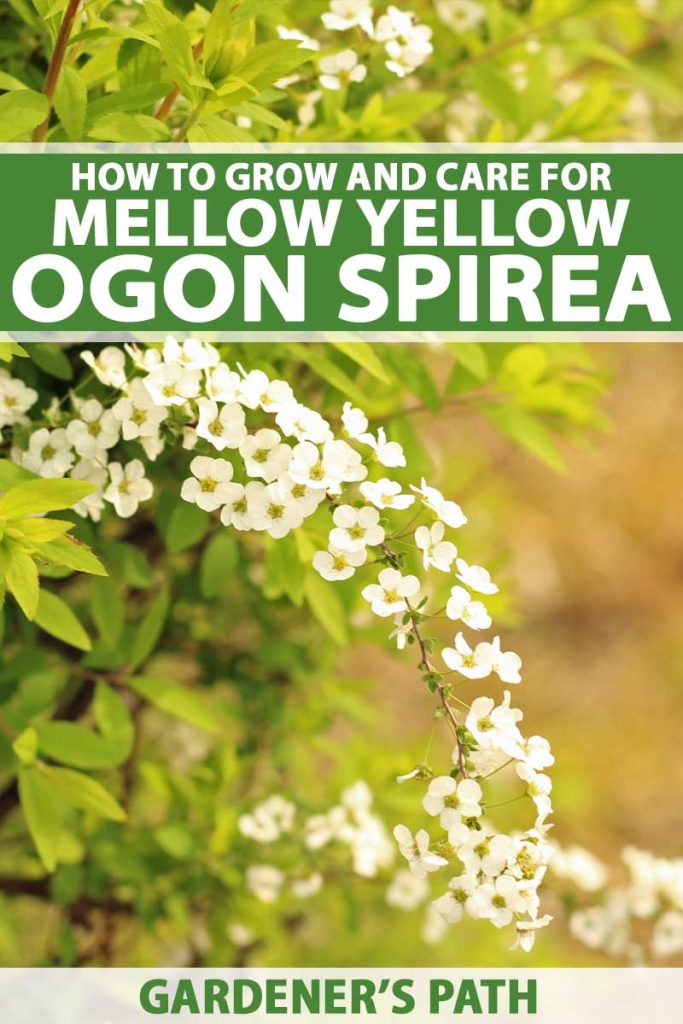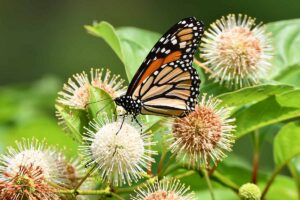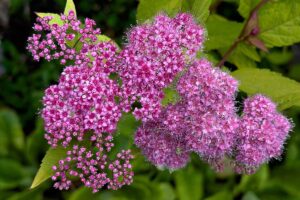Spiraea thunbergii ‘Ogon’ (Mellow Yellow)
Baby’s breath spirea, Spiraea thunbergii, is an ornamental woody shrub in the Rosaceae family. It has gracefully arching stems and slender, slightly-serrated lanceolate leaves.
The ‘Ogon’ cultivar, S. thumbergii ‘Ogon’, aka Mellow Yellow, is noteworthy for its early spring bloom time and golden leaves.

We link to vendors to help you find relevant products. If you buy from one of our links, we may earn a commission.
In this article, you’ll learn how to cultivate this landscape plant for foundation or stand-alone placements, as well as mixed borders and hedges.
What You Will Learn
Cultivation and History
The Spiraea thunbergii species is native to China and Japan. The true species and its cultivars are suitable for US Hardiness zones 4 to 8. It is known by various names, including baby’s breath, golden bridal wreath, and Thunberg spirea; as well as Thunberg’s meadowsweet.
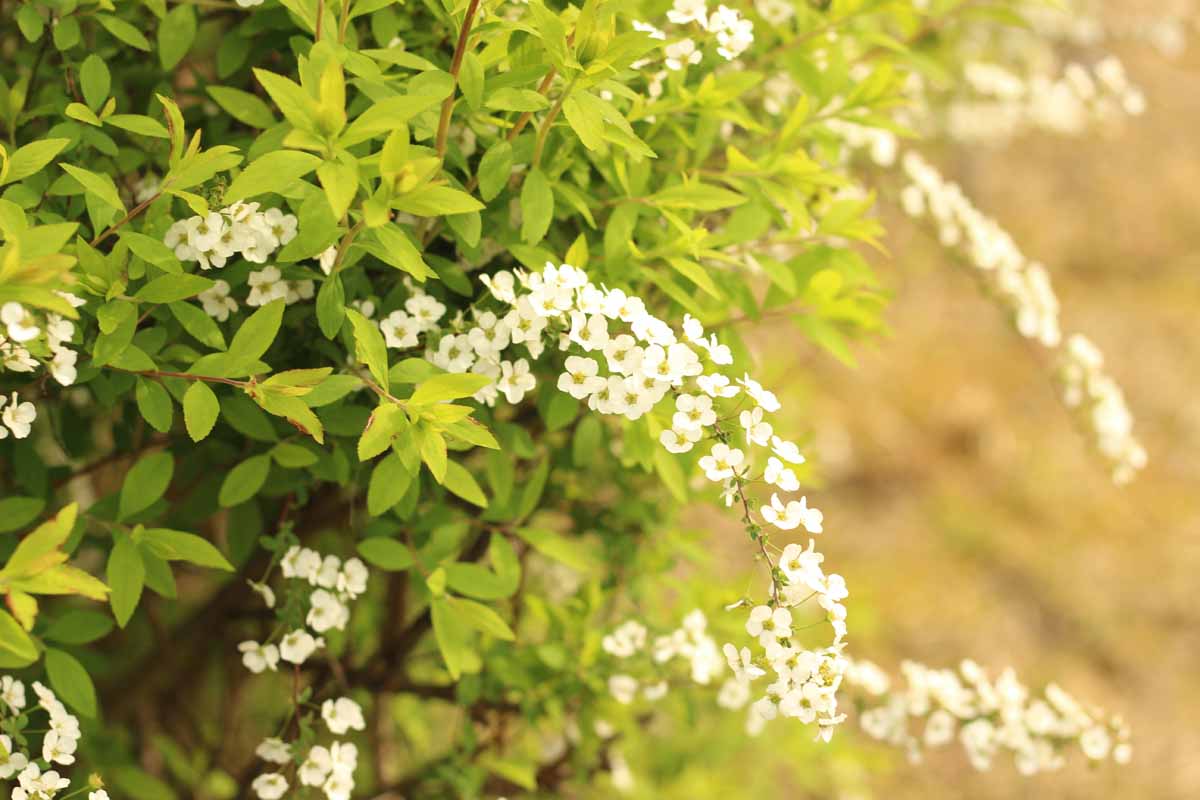
Please note that S. thunbergii is considered invasive in parts of the US, including: Alabama, Mississippi, Louisiana, Maryland, Pennsylvania (Blair County), New York (Fulton County), Connecticut (New Haven). It is prized as a Plant of Merit in the Midwest.
The ‘Ogon’ cultivar is an early bloomer with a loose, mounding habit that reaches a height and width of 3 to 5 feet. It puts on a show in spring, its cascading stems laden with petite white blossoms that resemble tiny English roses.
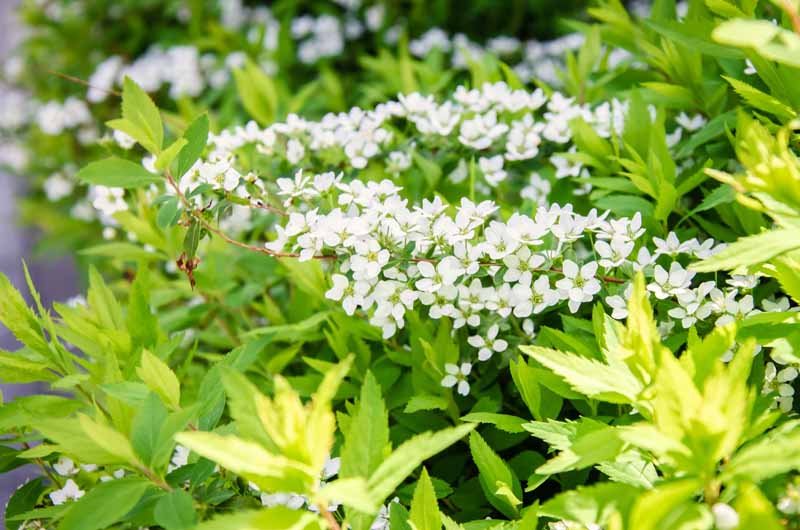
Golden leaves follow the flowers, deepening to bright green, for a nice contrast to dark evergreens in the landscape. By fall, the leaves take on bronze tones.
As the last of the leaves drop and winter gets underway, exfoliating bark is the predominant feature, punctuating the barren landscape with a maze of stark, textural lines.
Propagation
Spirea may be propagated from cuttings or by layering.

Cuttings are taken in one of two ways. In the summertime, soft, supple young stems are cut, dipped in rooting hormone, and planted in potting medium.
Alternatively, hard woody stems are cut just before spring, dipped in rooting hormone, and placed in potting medium.
In the layering method, a long, arching stem is bent to the ground, partially severed, and coated with rooting hormone. It is then covered with soil and weighed down with a rock. The rooted stem portion is then detached from the parent and transplanted.
The mature plants you find at a nursery were started in one of these three ways, and are established and ready for transplant into the ground, or a container.
If you are container gardening, choose a pot with a diameter at least twice as wide as twice as deep as the root ball, and be prepared to go up in size as the plant reaches its mature stature.
Read more about propagating spirea here.
How to Grow
This is an easy plant to grow. You may put it in the ground at any time between spring and fall.
- Start by choosing a sunny location. Part shade is okay, but you might have fewer flowers and lighter leaf hues.
- Any soil is fine, provided it drains well. A pH that is slightly acidic to neutral is best (6.0 to 7.0). Conduct a soil test and apply amendments such as bone meal or lime as directed in your soil report.
- Plan to allow for maximum dimensions of up to five feet tall and wide, with 18 to 24 inches between mature plants.
- Dig down into the soil as deep as the nursery pot and about twice as wide. Work the soil to a friable consistency before removing it and setting it aside.
- Gently work the pot off the root ball and tease the roots a bit to loosen them.
- Place the root ball into the ground at the same depth it was in the pot, and set it straight.
- Fill the soil back in around the roots and tamp it down.
- Make a well about a foot out from the plant with a ridge of soil.
- Water until it all soaks in and then repeat. Gently tamp down a second time.
- You may apply a balanced, slow-release fertilizer per package instructions at this time.
- You may also add a layer of compost or mulch to aid in water retention.
- Maintain even moisture until established, about an inch per week.
This is a long-lived shrub with good drought tolerance. It’s deer resistant, can withstand pollution, and attracts bees and butterflies.
Growing Tips:
- A sunny location yields optimal blooming and leaf color.
- Manipulate acidity as directed by a soil report.
- Prepare a hole as deep and twice as wide as the nursery pot.
- Place the root ball at the same depth it was in the pot.
- Apply a balanced, slow-release fertilizer at the time of planting and periodically per package instructions.
- Maintain even moisture during the transplant stage.
Pruning and Maintenance
To rejuvenate this plant, use a pair of sharp pruners, to remove some of the oldest, woodiest stems. Cut them to the ground just after flowering in the spring.
You may also prune deeply every few years, to a height of about 12 inches, to encourage healthy, new growth.
Fall-planted shrubs benefit from a protective layer of burlap and an extra layer of mulch to weather their first winter.
And while somewhat drought tolerant, in the event of a severe heatwave/dry spell, you should provide supplemental water to minimize stress.
And finally, apply a balanced, slow-release fertilizer in late fall or early spring each year.
Where to Buy
Ogon spirea (Mellow Yellow), Spiraea thunbergii ‘Ogon’, is available from Green Promise Farms via Amazon.

Managing Pests and Disease
S. thunbergii is not a pest- or disease-prone plant. However, if it’s stressed due to conditions like inadequate space between plants, inefficient soil drainage, over- or under-watering, or poor weed control, it fall victim to problems associated with its near relative, the rose.
Some insects to watch out for are: aphids, leaf rollers, scale, and spider mites. An application of food grade diatomaceous earth is one method of preventing/treating an onslaught.
Potential diseases include: fire blight, leaf spot, powdery mildew, and root rot. The removal of affected leaves and stems, and the application of a chemical fungicide or a biofungicide may halt the spread of some.
However, root rot from oversaturation may be irreversible.
Best Uses
To show off your Mellow Yellow beauty to best advantage, consider planting it alone as a specimen. This provides ample room to be seen from all sides, as it shows off its blossoms in spring, golden leaves in summer, and bronze tones in fall.
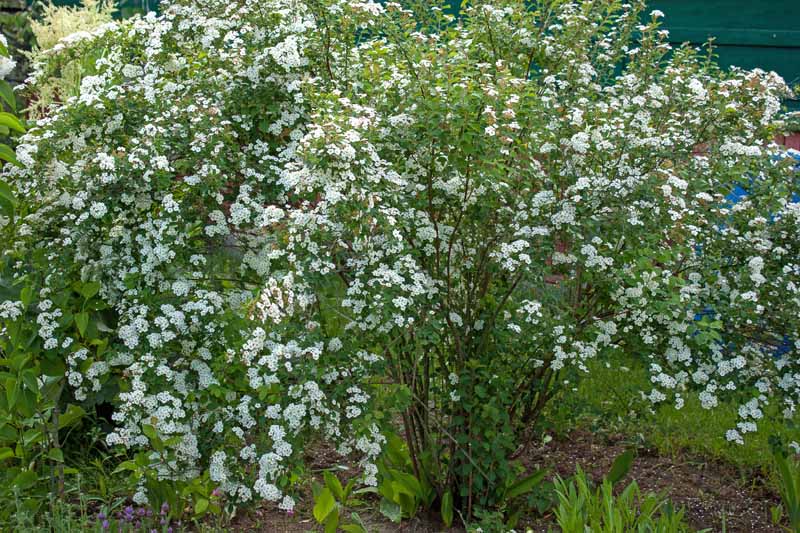
You may prefer to include it in a mixed border or bed with shrubs of various colors, statures, and textures, like evergreens, forsythia, fothergilla, juniper, roses, viburnum, and weigela.
It’s also an excellent choice for adding textural appeal and an anchor to the back of a foundation bed, particularly in spring, with a front edging of bulbs in bloom.

And if you’re looking for a plant to use as a hedge along a driveway, or a property perimeter by a busy road, S. thunbergii offers an airy, colorful alternative to dense and compact choices like privet or boxwood, as it absorbs fumes and creates privacy.
Quick Reference Growing Chart
| Plant Type: | Mellow Yellow ‘Ogon’ Spirea | Flower / Foliage Color: | White flowers, yellow/bronze leaves |
| Native to: | China and Japan | Maintenance: | Minimal |
| Hardiness (USDA Zone): | 4-8 | Soil Type: | Not picky; all |
| Bloom Time: | Early spring | Soil pH: | Neutral to slightly acidic, 6.0-7.0 |
| Exposure: | Full sun to part shade | Soil Drainage: | Well-draining |
| Growth Rate: | Fast | Companion Planting: | Evergreens, forsythia, fothergilla, juniper, rose, spring bulbs, viburnum, weigela |
| Spacing: | 18-24 inches | Uses: | Foundation plantings, hedges, large containers, mixed borders, specimens |
| Planting Depth: | As deep as the nursery pot, and twice the width | Attracts: | Bees and butterflies |
| Height: | 3 to 5 feet | Family: | Rosaceae |
| Spread: | 3 to 5 feet | Genus: | Amygdaloideae |
| Tolerance: | Drought, pollution, deer | Species: | spiraea |
| Pests & Diseases: | Aphids, fire blight, leaf rollers, leaf spot, powdery mildew, root rot, scale | Cultivar: | thunbergii |
Get Mellow with Yellow
No plant makes me happier than one that has something interesting to look at in every season, attracts beneficial insects, and comes up every year for a long time. Add good resistance to insects and disease, and minimal maintenance, and I’m in love.
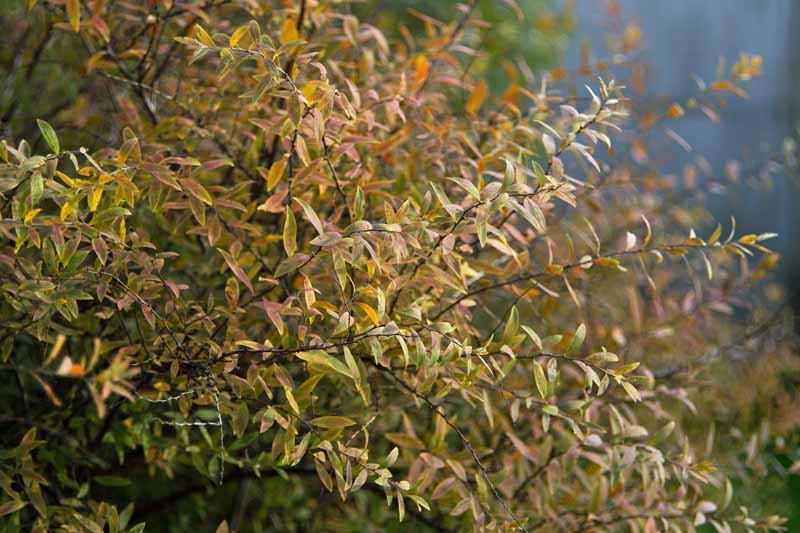
Imagine relaxing in springtime beside cascading blossoms, summers of golden leaves, and autumn’s bronze display.
Make room for S. thunbergii ‘Ogon’ in your landscape this year. Whether you grow it in large containers or in the ground, it’s a shrub that’s sure to please.
If you found this informative, you may like more of our spirea guides such as:
